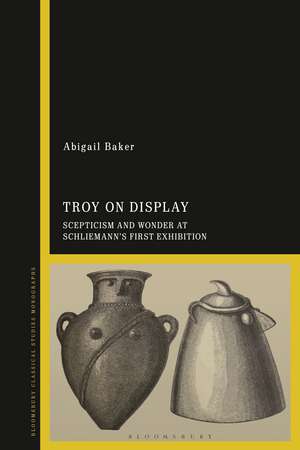Troy on Display: Scepticism and Wonder at Schliemann's First Exhibition
Autor Dr Abigail Bakeren Limba Engleză Hardback – 2 oct 2019
| Toate formatele și edițiile | Preț | Express |
|---|---|---|
| Paperback (1) | 218.54 lei 6-8 săpt. | |
| Bloomsbury Publishing – 21 apr 2021 | 218.54 lei 6-8 săpt. | |
| Hardback (1) | 657.29 lei 6-8 săpt. | |
| Bloomsbury Publishing – 2 oct 2019 | 657.29 lei 6-8 săpt. |
Preț: 657.29 lei
Preț vechi: 943.58 lei
-30% Nou
Puncte Express: 986
Preț estimativ în valută:
125.77€ • 131.67$ • 104.07£
125.77€ • 131.67$ • 104.07£
Carte tipărită la comandă
Livrare economică 05-19 aprilie
Preluare comenzi: 021 569.72.76
Specificații
ISBN-13: 9781788313582
ISBN-10: 1788313585
Pagini: 280
Dimensiuni: 156 x 234 x 21 mm
Greutate: 0.54 kg
Editura: Bloomsbury Publishing
Colecția Bloomsbury Academic
Locul publicării:London, United Kingdom
ISBN-10: 1788313585
Pagini: 280
Dimensiuni: 156 x 234 x 21 mm
Greutate: 0.54 kg
Editura: Bloomsbury Publishing
Colecția Bloomsbury Academic
Locul publicării:London, United Kingdom
Caracteristici
Focuses on the cultural and societal impact of the discovery, moving beyond the details of artifact and stratigraphy
Notă biografică
Abigail Baker is Assistant Keeper of Archaeology at the Great North Museum, Hancock, UK. Her research focuses on the reception of classical archaeology in museums, both past and present.
Cuprins
List of figuresAcknowledgementsPart 1: Introduction 1. Troy and TruthPart 2: Putting Troy on show 2. Bringing Troy to London 3. Making sense of the Trojan collection 4. How Schliemann Displayed his TreasuresPart 3: Schliemania? 5. Visualising Troy 6. The Appeal of the Primitive 7. Laughing at Schliemann 8. Weighing up Ancient TroyPart 4: Troy's place in History 9. The Other Homeric Question 10. How old was Troy? 11. Who Were the Trojans? Part 5: Successors and legacy 12. Jane Harrison's Odyssey 13. Arthur Evans' Labyrinth 14. Dream and realityNotesBibliographyIndex
Recenzii
The study explores the wide-ranging impact of the exhibition on various aspects of 19th-century thought, "bringing together a range of receptions [to build] a composite picture of the exhibition" (p. 32). Baker's multifaceted approach touches on the specific ways that the Trojan exhibition impacted contemporary receptions, from fashion to monetary policy, but also relates Troy itself to larger cultural debates on ancient chronology and racial theory . Summing Up: Highly recommended. Lower-division undergraduates through faculty.
This handy little book, which can be read in one sitting, is a gold-mine of fascinating information. It also sets any reader (this reviewer included) thinking about the wider questions.
Baker's volume convincingly achieves its goal of demonstrating how much can be gained from considering temporary exhibitions and is to be commended for its accessible, engaging style ... A useful contribution to scholarship on Schliemann and a highly enjoyable read.
This handsomely produced, generously illustrated book expands the final chapter of Abigail Baker's PhD thesis into 14 chapters, appraising the sociocultural environment of the first museum display of Schliemann's finds from Troy and that exhibition's effects on subsequent attitudes to prehistoric archaeology.
Dr. Baker shows us the care with which Schliemann staged his exhibit, revealing a clear and calculating intent on his part to persuade the viewers that his views on Troy were the correct ones . [She] has successfully shown us that 'Troy with its untrustworthy excavator, archaeological complexity and combination of truth and fiction is an unusually fruitful site for thinking about what fascinates us about the past and questioning the methods we use to understand it' ( 16).
There is much to interest archaeologists, museologists, and historians in this excellent book, and it is written in a flowing and engaging style that also invites a non-specialist readership.
This handy little book, which can be read in one sitting, is a gold-mine of fascinating information. It also sets any reader (this reviewer included) thinking about the wider questions.
Baker's volume convincingly achieves its goal of demonstrating how much can be gained from considering temporary exhibitions and is to be commended for its accessible, engaging style ... A useful contribution to scholarship on Schliemann and a highly enjoyable read.
This handsomely produced, generously illustrated book expands the final chapter of Abigail Baker's PhD thesis into 14 chapters, appraising the sociocultural environment of the first museum display of Schliemann's finds from Troy and that exhibition's effects on subsequent attitudes to prehistoric archaeology.
Dr. Baker shows us the care with which Schliemann staged his exhibit, revealing a clear and calculating intent on his part to persuade the viewers that his views on Troy were the correct ones . [She] has successfully shown us that 'Troy with its untrustworthy excavator, archaeological complexity and combination of truth and fiction is an unusually fruitful site for thinking about what fascinates us about the past and questioning the methods we use to understand it' ( 16).
There is much to interest archaeologists, museologists, and historians in this excellent book, and it is written in a flowing and engaging style that also invites a non-specialist readership.
